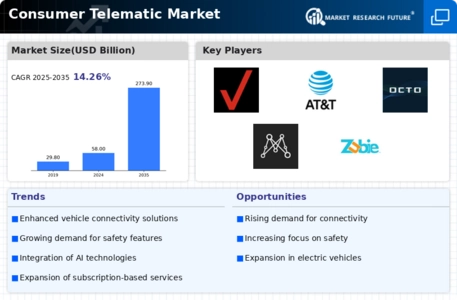Advancements in Data Analytics
Advancements in data analytics are significantly influencing the Consumer Telematic Market. The ability to collect and analyze vast amounts of data from vehicles enables manufacturers and service providers to offer personalized experiences to consumers. Enhanced data analytics tools allow for predictive maintenance, which can reduce vehicle downtime and improve overall efficiency. The market for automotive data analytics is expected to reach approximately 10 billion by 2026, reflecting the growing importance of data-driven decision-making in the industry. This trend not only enhances the value proposition for consumers but also fosters a competitive landscape where companies that leverage data analytics effectively can differentiate themselves. Consequently, the integration of sophisticated data analytics into telematics solutions is likely to be a key driver of growth within the Consumer Telematic Market.
Rising Demand for Connected Vehicles
The Consumer Telematic Market is experiencing a notable surge in demand for connected vehicles. This trend is largely driven by consumers' increasing desire for enhanced connectivity and convenience. According to recent data, the number of connected vehicles is projected to reach over 500 million by 2025, indicating a robust growth trajectory. This demand is fueled by the integration of advanced telematics systems that provide real-time data on vehicle performance, navigation, and entertainment. As consumers become more accustomed to seamless connectivity in their daily lives, the expectation for similar experiences in their vehicles intensifies. Consequently, automakers are investing heavily in telematics solutions to meet these evolving consumer preferences, thereby propelling the growth of the Consumer Telematic Market.
Government Regulations and Initiatives
Government regulations and initiatives play a pivotal role in shaping the Consumer Telematic Market. Various countries are implementing stringent regulations aimed at enhancing vehicle safety and environmental sustainability. For instance, mandates for vehicle-to-everything (V2X) communication are becoming more prevalent, encouraging the adoption of telematics solutions that facilitate safer driving conditions. Additionally, governments are promoting the use of telematics for fleet management, which is expected to grow at a compound annual growth rate of over 15% in the coming years. These regulatory frameworks not only drive innovation within the industry but also create a conducive environment for the proliferation of telematics technologies. As a result, the Consumer Telematic Market is likely to witness accelerated growth as stakeholders adapt to these evolving regulatory landscapes.
Consumer Preference for Safety and Security
Consumer preference for safety and security features is a critical driver in the Consumer Telematic Market. As awareness of road safety increases, consumers are actively seeking vehicles equipped with advanced telematics systems that enhance safety measures. Features such as emergency response services, real-time vehicle tracking, and driver behavior monitoring are becoming essential components of modern vehicles. Research indicates that nearly 70% of consumers prioritize safety features when purchasing a vehicle, underscoring the importance of telematics in meeting these expectations. This heightened focus on safety not only influences consumer purchasing decisions but also compels manufacturers to innovate and integrate advanced telematics solutions into their offerings. As a result, the Consumer Telematic Market is likely to continue evolving in response to these consumer demands for enhanced safety and security.
Growth of Ride-Sharing and Mobility Services
The growth of ride-sharing and mobility services is reshaping the Consumer Telematic Market. As urbanization accelerates, more consumers are opting for shared mobility solutions over traditional vehicle ownership. This shift is driving demand for telematics systems that facilitate efficient fleet management and enhance user experiences. The ride-sharing market is projected to exceed 200 billion by 2025, indicating a substantial opportunity for telematics providers. These services rely heavily on real-time data to optimize routes, monitor vehicle conditions, and ensure passenger safety. Consequently, the integration of telematics in ride-sharing platforms is becoming increasingly vital, as it not only improves operational efficiency but also enhances customer satisfaction. This trend is likely to propel the Consumer Telematic Market forward as it adapts to the evolving landscape of mobility services.


















Leave a Comment